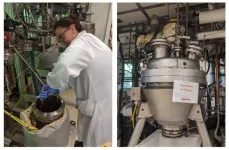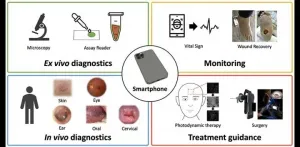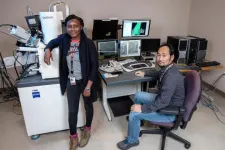(Press-News.org) Reliance on petroleum fuels and raging wildfires: Two separate, large-scale challenges that could be addressed by one scientific breakthrough.
Teams from Lawrence Berkeley National Laboratory (Berkeley Lab) and Sandia National Laboratories have collaborated to develop a streamlined and efficient process for converting woody plant matter like forest overgrowth and agricultural waste - material that is currently burned either intentionally or unintentionally - into liquid biofuel. Their research was published recently in the journal ACS Sustainable Chemistry & Engineering.
"According to a recent report, by 2050 there will be 38 million metric tons of dry woody biomass available each year, making it an exceptionally abundant carbon source for biofuel production," said Carolina Barcelos, a senior process engineer at Berkeley Lab's Advanced Biofuels and Bioproducts Process Development Unit (ABPDU).
However, efforts to convert woody biomass to biofuel are typically hindered by the intrinsic properties of wood that make it very difficult to break down chemically, added ABPDU research scientist Eric Sundstrom. "Our two studies detail a low-cost conversion pathway for biomass sources that would otherwise be burned in the field or in slash piles, or increase the risk and severity of seasonal wildfires. We have the ability to transform these renewable carbon sources from air pollution and fire hazards into a sustainable fuel."
In a study led by Barcelos and Sundstrom, the scientists used non-toxic chemicals, commercially available enzymes, and a specially engineered strain of yeast to convert wood into ethanol in a single reactor, or "pot." Furthermore, a subsequent technological and economic analysis helped the team identify the necessary improvements required to reach ethanol production at $3 per gasoline gallon equivalent (GGE) via this conversion pathway. The work is the first-ever end-to-end process for ethanol production from woody biomass featuring both high conversion efficiency and a simple one-pot configuration. (As any cook knows, one-pot recipes are always easier than those requiring multiple pots, and in this case, it also means lower water and energy usage.)
In a complementary study, led by John Gladden and Lalitendu Das at the Joint BioEnergy Institute (JBEI), a team fine-tuned the one-pot process so that it could convert California-based woody biomass - such as pine, almond, walnut, and fir tree debris - with the same level of efficiency as existing methods used to convert herbaceous biomass, even when the input is a mix of different wood types.
"Removing woody biomass from forests, like the overgrown pines of the Sierra, and from agricultural areas like the almond orchards of California's Central Valley, we can address multiple problems at once: disastrous wildfires in fire-prone states, air pollution hazards from controlled burning of crop residues, and our dependence on fossil fuels," said Das, a postdoctoral fellow at JBEI and Sandia. "On top of that, we would significantly reduce the amount of carbon added to the atmosphere and create new jobs in the bioenergy industry."
Ethanol is already used as an emissions-reducing additive in conventional gasoline, typically constituting about 10% of the gas we pump into our cars and trucks. Some specialty vehicles are designed to operate on fuel with higher ethanol compositions of up to 83%. In addition, the ethanol generated from plant biomass can be used as an ingredient for making more complex diesel and jet fuels, which are helping to decarbonize the difficult-to-electrify aviation and freight sectors. Currently, the most common source of bio-based ethanol is corn kernels - a starchy material that is much easier to break down chemically, but requires land, water, and other resources to produce.
These studies indicate that woody biomass can be efficiently broken down and converted into advanced biofuels in an integrated process that is cost-competitive with starch-based corn ethanol. These technologies can also be used to produce "drop-in" biofuels that are chemically identical to compounds already present in gasoline and diesel.
The next steps in this effort is to develop, design, and deploy the technology at the pilot scale, which is defined as a process that converts 1 ton of biomass per day. The Berkeley Lab teams are working with Aemetis, an advanced renewable fuels and biochemicals company based in the Bay Area, to commercialize the technology and launch it at larger scales once the pilot phase is complete.
INFORMATION:
This research was supported by the California Energy Commission and the U.S. Department of Energy (DOE) Office of Science. JBEI is a DOE Bioenergy Research Center dedicated to developing advanced biofuels. The ABPDU, funded by the DOE Bioenergy Technologies Office, is a Berkeley Lab-led facility that works with industry, academia, and other national laboratories to develop and optimize bio-based processes for producing chemicals, materials, and fuels.
Founded in 1931 on the belief that the biggest scientific challenges are best addressed by teams, Lawrence Berkeley National Laboratory and its scientists have been recognized with 14 Nobel Prizes. Today, Berkeley Lab researchers develop sustainable energy and environmental solutions, create useful new materials, advance the frontiers of computing, and probe the mysteries of life, matter, and the universe. Scientists from around the world rely on the Lab's facilities for their own discovery science. Berkeley Lab is a multiprogram national laboratory, managed by the University of California for the U.S. Department of Energy's Office of Science.
DOE's Office of Science is the single largest supporter of basic research in the physical sciences in the United States, and is working to address some of the most pressing challenges of our time. For more information, please visit energy.gov/science.
DURHAM, N.C. - Researchers at Duke University have developed a method that uses machine learning, satellite imagery and weather data to autonomously find hotspots of heavy air pollution, city block by city block.
The technique could be a boon for finding and mitigating sources of hazardous aerosols, studying the effects of air pollution on human health, and making better informed, socially just public policy decisions.
"Before now, researchers trying to measure the distribution of air pollutants throughout a city would either try to use the limited number of existing monitors or drive sensors around a city in vehicles," said Mike ...
A team of scientists used a telescope on the International Space Station to measure the size of PSR J0740+6620 (J0740, for short), the most massive known neutron star. NASA's Neutron star Interior Composition Explorer (NICER) has captured unprecedented detail from this stellar remnant to learn more about matter in its core, which is on the threshold of collapsing into a black hole.
The NICER team will introduce their groundbreaking findings at a press conference during the 2021 APS April Meeting. NASA astronaut Christina Koch will join them to talk about how researchers use the space station as a science platform.
From pencils to pulsars
"Matter makes up everything we can see in the universe, from pencils ...
Researchers from Skoltech and a major European bank have developed a neural network that outperforms existing state-of-the art solutions in using transactional banking data for customer credit scoring. The research was published in the proceedings of the 2020 IEEE International Conference on Data Mining (ICDM).
Machine learning algorithms are already extensively used in risk management, helping banks assess clients and their finances. "A modern human, in particular a bank client, continually leaves traces in the digital world. For instance, the client may add information about transferring money to another person in a payment system. Therefore, every person obtains a large number of connections that can be represented as a directed graph. Such a graph gives an additional ...
A new study by Texas A&M University researchers published in END ...
Smartphones get smarter every day. These "Swiss Army knives" of mobile computing become even more useful with specialized attachments and applications to improve healthcare. Based on inherent capabilities like built-in cameras, touchscreens, and 3D sensing, as well wearable peripheral devices, custom interfaces for smartphones can yield portable, user-friendly biomedical imaging systems to guide and facilitate diagnosis and treatment in point-of-care settings.
What are the most effective ways to leverage and augment smartphone capabilities? Helpful guidelines are provided in a critical review of emerging smartphone-based imaging systems END ...
An imaging agent allows scientists to better visualize Enterobacterales infections in patients, helping to address pathogens that can be life-threatening and frequently resist antibiotics. The agent was safe in 26 patients and differentiated infections from either sterile inflammation or COVID-19-linked pneumonia in hamsters. Enterobacterales is the largest group of disease-causing bacteria in humans, and includes common pathogens such as Escherichia coli, Salmonella, and Klebsiella pneumoniae. These species have become increasingly resistant to common antibiotics, which has led the Centers for Disease Control to label some drug-resistant strains as urgent threats to human health. However, scientists still lack tools that can rapidly ...
New research from the Florida State University College of Medicine has found that the personality trait neuroticism is consistently associated with a higher risk of developing the brain disorder Parkinson's disease.
The research by Professor of Geriatrics Antonio Terracciano and team, published in Movement Disorders, found that adults in the study who scored in the top quartile of neuroticism had more than 80% greater risk of Parkinson's, compared to those who scored lower on neuroticism.
"Some clinicians think that the anxiety and depression is just the result of Parkinson's," Terracciano said. "However, our findings suggest that some emotional vulnerability is present early in life, ...
AMHERST, Mass. - Last month saw the average concentration of atmospheric carbon dioxide (CO2) climb to almost 418 parts-per-million, a level not seen on Earth for millions of years. In order to get a sense of what our future may hold, scientists have been looking to the deep past. Now, new research from the University of Massachusetts Amherst, which combines climate, ice sheet and vegetation model simulations with a suite of different climatic and geologic scenarios, opens the clearest window yet into the deep history of the Antarctic ice sheet and what our planetary future might hold.
The Antarctic ice sheet has attracted the particular interest of the scientific community because it is "a lynchpin in the earth's climate system, affecting everything from ...
Financial stress can have an immediate impact on well-being, but can it lead to physical pain nearly 30 years later? The answer is yes, according to new research from University of Georgia scientists.
The study, published in Stress & Health, reveals that family financial stress in midlife is associated with a depleted sense of control, which is related to increased physical pain in later years.
"Physical pain is considered an illness on its own with three major components: biological, psychological and social," said Kandauda A.S. Wickrama, first author and professor in the College of Family and Consumer Sciences. "In older adults, it co-occurs with other health problems like limited physical functioning, loneliness and cardiovascular ...
Florida State University researchers have discovered a novel way to improve the performance of electrical wires used as high-temperature superconductors (HTS), findings that have the potential to power a new generation of particle accelerators.
An image of Bi-2212, bismuth-based superconducting wires. (Mark Wallheiser/FAMU-FSU College of Engineering)
Researchers used high-resolution scanning electron microscopy to understand how processing methods influence grains in bismuth-based superconducting wires (known as Bi-2212). Those grains form the underlying ...





